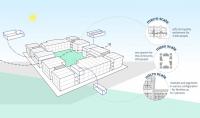Architects from WUT will create a modular refugee settlement

The project assumes the preparation of apartments with social infrastructure for about 3.5 thousand people
The concept of a modular settlement for Ukrainian refugees is being developed at the Faculty of Architecture at the WUT. It will be used to develop general guidelines and standards for this type of residential complex.
It is estimated that there are about 11 million people among Ukrainian refugees who have moved within the country. This group especially needs housing, but not temporary housing, but housing that will serve them for a long time and help to regain a sense of community and belonging.
– In the case of similar settlements for refugees, the average period of residence is about 17 years, i.e. a period of growing up. For this reason, we are generally opposed to temporary solutions – says Prof. Anna Maria Wierzbicka from the Faculty of Architecture at the WUT, who manages design works. – The place of residence is not just a roof over your head. Equally important is the capacity to meet other needs – security, belonging and identity. We must also not forget about the appropriate standard and energy efficiency – she emphasizes.
As part of the urban and architectural concept, segment projects will be created in a modular system for families with different number of members. In addition, it will be possible to re-join and divide them. Variants of segment combinations in the form of development quarters will be developed. In turn, on the macro scale, a residential complex for about 3.5 thousand people will be created. The proposals are intended to ensure an adequate standard of living, the necessary social infrastructure and ecological solutions.
The academic community from Poland and Ukraine and the refugees who came to Poland will be involved in the work.
The Polish modular settlement project for the refugee population "Modular Refugee Settlement Project" (ProModSe) was selected for implementation by the European Institute of Innovation and Technology (EIT) Community New European Bauhaus. The EIT is a body of the European Union.
From the Faculty of Architecture of the WUT, in the project the following were involved: Prof. Anna Maria Wierzbicka, Yuriy Kryvoruchko (visiting professor from the Lviv University of Technology), Ph.D. Arch., Paweł Trębacz, Ph.D. Arch., Renata Jóźwik, Ph.D. Arch., Magdalena Duda, MSc, Eng. Arch.






